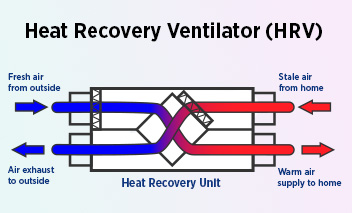Exploring HRV: A Complete Overview
Wiki Article
The All-Inclusive Guide to the Uses of Heat Recovery Ventilation in Modern Buildings
Heat Recovery Ventilation (HRV) systems represent a significant improvement in building innovation (HRV Heat Recovery Ventilation). They provide a technique for exchanging stagnant indoor air with fresh outdoor air while reducing energy loss. This technique not only improves interior air top quality but additionally adds to energy performance in both property and business structures. Understanding the different applications and benefits of HRV can reveal its critical function in modern style and sustainability initiatives. The effects of this technology deserve checking out furtherUnderstanding Heat Recovery Ventilation Equipments

Although numerous modern-day buildings prioritize power performance, recognizing warm recovery ventilation (HRV) systems is vital for maximizing interior air quality and minimizing power consumption. HRV systems function by transferring warm from stale indoor air to incoming fresh air, successfully preserving comfy interior temperature levels while reducing power loss. These systems contain a warmth exchanger, followers, and ductwork that assist in the circulation of air. Throughout wintertime, HRV devices catch and reuse heat from the outgoing air, while in summer season, they can aid cool incoming air. By continuously trading air, HRV systems additionally lower moisture and the concentration of indoor pollutants. Correct installation and upkeep of HRV systems are vital for their effectiveness and performance in boosting overall building efficiency and comfort.
Benefits of Heat Recovery Ventilation
Heat recovery ventilation systems provide numerous advantages that improve both power performance and interior air quality in contemporary buildings. By capturing and reusing energy from exhaust air, these systems substantially lower cooling and heating expenses, resulting in lower power intake. They preserve a steady circulation of fresh outside air, minimizing the risk of indoor air contaminants and irritants. This constant exchange helps control moisture levels, protecting against mold development and making certain a much healthier living setting. In addition, HRV systems contribute to sustainability objectives by reducing overall carbon footprints. Their ability to optimize ventilation without giving up thermal convenience makes them a beneficial addition to contemporary structure style, advertising both economic and environmental advantages.Applications of HRV in Residential Buildings
As house owners increasingly prioritize energy efficiency and indoor air high quality, the applications of warm recuperation ventilation (HRV) systems in property buildings have come to be extra widespread. HRV systems are specifically valuable in snugly secured homes, where preserving fresh air circulation is vital for stopping moisture build-up and interior pollutants. They properly transfer warmth from outbound stale air to incoming fresh air, lowering power costs connected with home heating and air conditioning. In addition, HRVs can enhance comfort degrees by controling moisture and temperature. They are additionally adaptable for different property designs, including single-family homes and multi-unit structures. Overall, integrating HRV systems sustains lasting living techniques while making sure a healthier indoor atmosphere for occupants.HRV in Commercial and Commercial Settings
In business and commercial settings, the application of warmth recovery ventilation (HRV) systems has become increasingly vital for optimizing power effectiveness and preserving air high quality. These systems efficiently transfer heat from exhaust air to incoming fresh air, lowering the requirement for added home heating or air conditioning. This not just reduces power costs however also adds to sustainability campaigns. Industries such as manufacturing, warehousing, and workplace structures profit substantially from HRV systems, as they assist manage temperature level and humidity degrees, guaranteeing a comfortable and effective atmosphere. HRV systems aid in getting rid of pollutants and excess wetness, improving interior air top quality. As guidelines around air top quality end up being more stringent, the adoption of HRV modern technology is likely to grow, making it a crucial component of contemporary commercial and industrial infrastructure.Future Patterns in Heat Recovery Ventilation Innovation

Frequently Asked Inquiries
How Does Heat Recovery Ventilation Effect Indoor Air High Quality?
Heat recovery ventilation considerably enhances indoor air quality by constantly trading stale interior air with fresh outdoor air while recuperating power. This procedure decreases toxins, preserves excellent humidity levels, and ensures a healthier environment for residents.Can HRV Solutions Be Mounted in Existing Structures?
HRV systems can without a doubt be installed in existing structures. Retrofitting might call for adjustments to ductwork and air flow layouts, but it substantially improves energy efficiency and indoor air high quality, making it a sensible choice for older frameworks.What Maintenance Is Needed for HRV Solutions?

Are There Particular Climates Where HRV Is A Lot More Efficient?
Heat recovery ventilation systems are HRV Heat Recovery Ventilation especially effective in climates with considerable temperature differences between periods. These systems maximize power efficiency by recouping warmth from exhaust air, making them ideal for both chilly and moderately warm environments.Just How Do HRV Equipments Affect Power Costs?

Report this wiki page